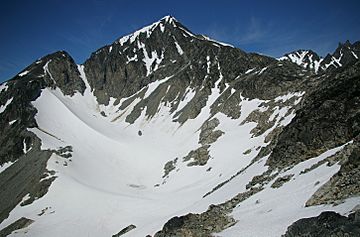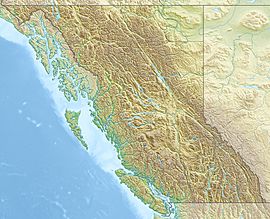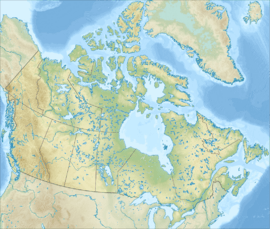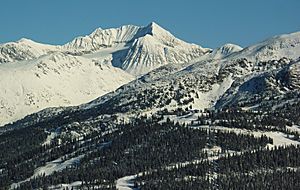Mount Weart facts for kids
Quick facts for kids Mount Weart |
|
|---|---|

Mount Weart, south summit featured, the highest of the three peaks
|
|
| Highest point | |
| Elevation | 2,835 m (9,301 ft) |
| Prominence | 365 m (1,198 ft) |
| Parent peak | Wedge Mountain (2895 m) |
| Geography | |
| Location | Garibaldi Provincial Park British Columbia, Canada |
| Parent range | Garibaldi Ranges Coast Ranges |
| Topo map | NTS 92J2 |
| Climbing | |
| First ascent | 1932 by B. Cook, P. Tait |
| Easiest route | Scrambling via southeast ridge |
Mount Weart is a huge mountain in British Columbia, Canada. It stands at 2,835-metre (9,301-foot) tall. This mountain is special because it has three main peaks! You can find it in the northwestern part of Garibaldi Provincial Park.
Mount Weart is part of the Garibaldi Ranges, which are a section of the larger Coast Mountains. It's located about 14 km (9 mi) northeast of Whistler. The only mountain taller than Mount Weart in the park is Wedge Mountain, which is just 3.7 km (2 mi) to the south.
You'll find two big glaciers on Mount Weart. The Armchair Glacier is on the west side. The even larger Weart Glacier covers the northern and eastern parts of the mountain. Water from these glaciers and from rain flows into Wedgemount Lake and then into the Lillooet River.
What's in a Name?
Before it was called Mount Weart, climbers knew this mountain as Armchair Mountain or The Armchair. This was because of its shape.
In 1928, the Garibaldi Park Board suggested the name "Mount Weart". They named it after their chairman at the time, John Walter Weart. He lived from 1861 to 1941. The name became official on September 2, 1930.
The very first time someone successfully climbed to the top of Mount Weart was in 1932. This amazing feat was achieved by two climbers, B. Cook and P. Tait.
Weather at Mount Weart
Mount Weart is in a place with a "marine west coast" climate. This means it gets a lot of rain and snow. Most of the weather comes from the Pacific Ocean. As these weather systems move east, they hit the Coast Mountains. The mountains force the air upwards, which makes it drop its moisture as rain or snow.
Because of this, the Coast Mountains get a lot of precipitation. Winters bring heavy snowfall. Temperatures can get very cold, sometimes dropping below −20 °C. With the wind, it can feel even colder, below −30 °C! The best time to try climbing Mount Weart is usually from July to September. This is when the weather is most favorable.
Climbing Mount Weart
Mount Weart is a popular spot for climbers. There are several known routes to reach its summits. Some of the established climbing routes include:





